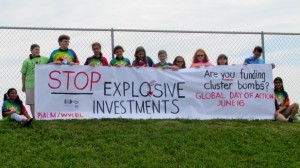A White House decision to suspend future cluster munition transfers to Saudi Arabia should be made permanent and extended to cover all cluster munition transfers.
According to Foreign Policy magazine the White House has suspended US transfers of cluster munitions to Saudi Arabia following concerns over civilian harm from their use in Yemen, where a Saudi-led coalition has been conducting a military operation against Ansar Allah (Houthi) forces since March 2015. The “exclusive” story by John Hudson published late in the afternoon on Friday, May 27, 2016 and sourced to an anonymous “senior US official” comes as criticism mounts at the lack of US response to civilian harm from the conflict in Yemen.
Comment by the Campaign
The Cluster Munition Coalition US welcomes the apparent decision to suspend US cluster munition transfers to Saudi Arabia and calls for it to be made permanent and extended to cover all cluster munition transfers to any country. CBU-105 Sensor Fuzed Weapons manufacturer Textron should stop accepting orders and shut down this product line, while the US should prohibit all production of cluster munitions, including those with a supposed unexploded ordnance (UXO) rate of less than 1%. The Cluster Munition Coalition US calls for an end to the cluster munitions attacks in Yemen. The campaign calls on the United States, Yemen, and Saudi Arabia and its coalition partners to accede to the ban treaty. It urges greater funding and technical support to clear and destroy cluster munition remnants, landmines and unexploded ordnance.
The Cluster Munition Coalition US seeks formal/official confirmation of the reported White House decision and what it covers. The US concluded a contract in 2013 to manufacture of 1,300 CBU-105 Sensor Fuzed Weapons for delivery to for Saudi Arabia by December 31, 2015, but, as Foreign Policy also notes, US officials have repeatedly refused to clarify if all the cluster munitions were delivered. A spokesperson for the CBU-105 manufacturer told Foreign Policy “Textron Systems does not comment on delivery dates with our customers,” while the Saudi Embassy in Washington DC did not respond to a request for comment.
According to the Foreign Policy article, the senior US official said the administration acknowledges reports by Human Rights Watch that the weapons had been used “in areas in which civilians are alleged to have been present or in the vicinity” and added: “We take such concerns seriously and are seeking additional information.”
Human Rights Watch has recorded the use of four types of air-dropped and ground-launched US cluster munitions in multiple locations in Yemen, while Amnesty International has documented the use of a Brazilian-made and a UK-made cluster munition. International and national media outlets and UN researchers have also documented cluster muniton attacks in Yemen. Human Rights Watch has recorded a total of 16 cluster munition attacks that have killed 19 civilians and wounded 66.
Three types of US cluster munitions used in Yemen are old stock manufactured decades ago that the US no longer exports. The other is the CBU-105 Sensor Fuzed Weapon, the only type of cluster munition the US currently exports. According to the US Department of Defense Defense Security Cooperation Agency, CBU-105 Sensor Fuzed Weapon are “the only cluster munition with a compliant submunition” with US export rules and a June 2008 policy directive.
Under the export law law provisions from December 2007 the US can only export cluster munitions that “after arming do not result in more than 1 percent unexploded ordnance across the range of intended operational environments,” and the receiving country must agree that cluster munitions “will only be used against clearly defined military targets and will not be used where civilians are known to be present or in areas normally inhabited by civilians.” Cluster munitions transferred before 2008 are not covered by these requirements.
Yet as the following research summary shows there is clear evidence that Saudi Arabia has used CBU-105 Sensor Fuzed Weapons in civilian areas of Yemen and mutiiple examples of the weapons not functioning in ways that meet the 1 percent reliability standard.
Use of CBU-105 Sensor Fuzed Weapons in Yemen
Since April 2015, Human Rights Watch and Amnesty International have published evidence of at least six attacks by the Saudi-led coalition involving the use of CBU-105 Sensor Fuzed Weapons attacks in four of Yemen’s 21 governorates: Amran, Hodaida, Saada, and Sanaa.
Al-Shaaf in Saada governorate, April 17, 2015 – The first recorded use of CBU-105 Sensor Fuzed Weapons in Yemen was in northern Saada governorate, the traditional Houthi stronghold bordering Saudi Arabia, on April 17. Human Rights Watch reported “credible evidence” on May 3, 2015, that CBU-105s were “hitting areas near villages, putting local people in danger.” Through a review of a video and analysis of satellite imagery it geolocated the site of an attack to al-Shaaf in Saqeen, in the western part of Saada governorate and issued a map showing the weapons appeared to land on a cultivated plateau, within 600 meters of several dozen buildings. Human Rights Watch identified the use of CBU-105 Sensor Fuzed Weapons from a video of the attack that shows numerous objects with parachutes slowly descending from the sky then zooming out to show a mid-air detonation and several black smoke clouds from other detonations. It found the white parachutes to be “consistent with the drogue chute color and design of the CBU-105 systems.”
Al-Amar in Saada governorate on April 27, 2015 – CBU-105s were used in an attack on the town of al-Amar in al-Safraa, about 35 kilometers south of Saada City, on April 27. Photos taken by locals after the attack show an expended BLU-108 canister and another with all four submunitions or “skeet” attached. During a field investigation, residents showed Human Rights Watch Watch researchers an unexploded submunition they collected after the attack and took them to the location where two BLU-108 canisters were found by the main road between Sanaa and Saada, about 100 meters south of al-Amar. The researchers found another empty BLU-108 canister in bushes nearby, making a total of at least three from the attack. Local residents and medical staff told Human Rights Watch that two or three people were wounded when air-dropped submunitions exploded on impact near al-Amar on April 27, at least two of them civilians.
Sanhan in Sanaa governorate on May 21, 2015 – CBU-105s were used in an attack on the Affash Historic Fort in the village of Bait al-Ahmar in Sanhan, about 20 kilometers south of Sanaa City in Sanaa governorate, on May 21. According to a report issued by Human Rights Watch in February 2016 there were no casualties in the attack, which occurred 500 meters from a residential area. A guard who witnessed the attack said he saw the remnants BLU-108 canisters with their parachutes still attached and at least 20 unexploded or submunitions or skeet when he returned a week later. He said some, but not all of the remnants were cleared and destroyed two weeks later by “a team of military engineers.” A photographer who visited the site in September 2015 said he saw at least eight BLU-108 canisters in the fort, and another three next to the compound’s mosque. He provided Human Rights Watch with a photo showing a BLU-108 canister with all four skeets or submunitions still attached, indicated it failed to function.
Harf Sofian in Amran governorate on June 29, 2015 – CBU-105s were used in an attack on Harf Sofian in Amran governorate, that locals said occurred on June 29, 2015, according to a report published by Amnesty International in October 2015. Amnesty International researchers visiting the area on July 6 found and photographed an empty BLU-108 canister lying in situ.
Al-Hayma in Hodaida governorate on December 12, 2015 – CBU-105s were used in an attack on a Yemeni port town in Hodaida governorate on December 12, 2015 that injured a woman and two children in their homes. Human Rights Watch published evidence in February 2016 including photographs of remnants from the attack and witness accounts, including from father of a four-year-old girl who had her lower right leg amputated afterwards. Another resident described watching about 20 white parachutes in the air and less than a minute later saw each one release a cloud of black smoke as it neared the ground.
Near al-Darb in Amran governornate on February 15, 2016 – The last reported incident involving the use of CBU-105s was in an attack on a cement factory in Amran governornate on February 15, 2016. A local reporter provided Human Rights Watch with a 37-second video that he said they filmed during the attack. It shows multiple distinctive black smoke clouds generated by the CBU-105 submunitions emanating from a strike behind a ridge line while multiple detonations can be heard in the video. Human Rights Watch researchers visited the factory in March 2016 and photographed remnants that were collected by factory workers after the attack, including a suspension lug and piece of a parachute from a BLU-108 canister used in the CBU-105. It reviewed photographs taken by workers of the remnants where they landed. At least three BLU-108 canisters are visible: one has all four “skeet” and its parachute still attached, while the others each have two “skeet” attached. This shows a failure to function as intended because the submunitions failed to disperse from the canister, or were dispersed but did not explode or self-destruct. An individual unexploded “skeet” is also shown on the ground where it landed.
None of these documented CBU-105 attacks in Yemen have involved armored vehicles nor have damaged or destroyed armored vehicles been documented at the strike locations. According to Textron,the CBU-105 is “not intended to target human beings at all…. They are made to target armored-vehicles.”
Saudi Arabia has repeatedly denied using other types of cluster munitions in Yemen, but has admitted to using CBU-105 Sensor Fuzed Weapons once in Yemen, in Hajjah governorate in April 2015. The UAE acknowledges that it has CBU-105s, but denies using them in Yemen. There is no evidence to indicate that other countries in the Saudi-led coalition – Bahrain, Egypt, Jordan, Kuwait, Morocco, Qatar, and Sudan – have received CBU-105s.
Pressure on US to stop cluster munition transfers to Saudi Arabia
A broad array of actors were involved in helping the White House reach its May 27 decision to suspend further transfers of the CBU-105 to Saudi Arabia, including Congressional Democrats and Republicans, non-governmental organizations and grassroots activists, and reporters who have followed this story.
Senators Patrick Leahy (D-VT) and Dianne Feinstein (D-CA) have for years urged the administration to take stronger action against cluster munitions to come in line with the 2008 Convention on Cluster Munitions. In recent weeks Congressional voices multiplied as part of broader attempts to curb US arms transfers to Saudi Arabia in light of compelling evidence of war crimes. Senators Chris Murphy (D-CT) and Rand Paul (R-KY) introduced legislation in April to block transfers of all air-to-ground munitions to Saudi Arabia until the president certifies that Saudi Arabia is taking steps to avoid civilian casualties and facilitate the flow of humanitarian aid. Representatives Ted Lieu (D-CA) and Ted Yoho (R-FL) introduced a companion bill in the House that picked up 5 new cosponsors in the week that ended with the White House decision.
Reps. John Conyers (D-MI), Raul Grijalva (D-AZ), Keith Ellison (D-MN), and Jim McGovern (D-MA) introduced an amendment to the national defense authorization act (NDAA) that would have prevented funds from being used “to transfer or authorize the transfer of any cluster munitions to Saudi Arabia.” The amendment was narrowly defeated by a handful of votes on June 16, 2016, by a vote of 204 to 216. The amendment sought to block funds from being used to transfer or authorize the transfer of cluster munitions to Saudi Arabia. 164 Democrats and 40 Republicans voted for the proposal, while 200 Republicans and 16 Democrats voted against it. The vote by almost half of the House of Representatives to suspend transfers of cluster munition shows widespread concern at the humanitarian impact of of these weapons, especially on civilians. It affirms public support for the emerging norm against cluster munitions due to the harm caused at the time of attack as well as from unexploded submunitions and other explosive remnants from their use.
In recent weeks, multiple Move On petitions have applied pressure on US lawmakers to act on the cluster munition attacks, incuding one calling on representatives to support an amendment to the National Defense Authorization Act to end or limit the production and transfer of cluster bombs.
Protestors from the American Friends Service Committee, Peace Action, and the FANG Collective demonstrated outside Textron’s corporate headquarters in Providence, Rhode Island on April 19 against the company’s production of banned cluster munitions. Textron representatives apparently refused to receive a petition signed by more than 3,000 people calling on the company to cease manufacturing cluster munitions. Two days later, Rhode Island police arrested Pia Ward and two other activists who chained themselves to Textron’s front doors during another protest against cluster munitions.
Campaigners have met on multiple occassions with US officials from the State Department and Department of Defense to discuss the evidence of cluster munition use in Yemen, as well as with diplomats from states that are party to the Convention on Cluster Munitions and states still outside it. On April 12, 2016, a diplomatic representative of the UAE told the Cluster Munition Coalition that the UAE has CBU-105 Sensor Fuzed Weapons but is not using them in Yemen because the weapons are banned by the Convention on Cluster Munitions.
Reports by Human Rights Watch and Amnesty International on the harm caused by cluster munitions in Yemen have received widespread media coverage and strong interest on social media. Journalists from the Incercept, Los Angeles Times, Mother Jones, The New York Times, Vice News, and other major publications have sought comment from US and Saudi officials in response to the attacks.
In February, Rhode Island reporter Bob Plain obtained a rare comment from a Textron spokesperson, who defended CBU-105 Sensor Fuzed Weapons as “intelligent” munitions and asserting that the company cannot be held liable if the weapons are misused, reportedly stating: “We’re not in the plane dropping the bomb. If it was dropped in an area that is perhaps too close to a civilian population, that is not supposed to happen.”
Plain has since written fifteen articles on the response to Textron’s cluster munition production and mounting concern at evidence of Saudi use of the weapons in Yemen.
The Cluster Munition Coalition US is coordinated by Human Rights Watch and comprised of US-based organizations working to encourage US accession to the 2008 Convention on Cluster Munitions. Follow @noclusterbombs on Twitter.
For more information, see:
- John Hudson, “Exclusive: White House Blocks Transfer of Cluster Bombs to Saudi Arabia,” Foreign Policy(May 2016)
- Human Rights Watch, “Yemen: Saudis Using US Cluster Munitions,” May 6, and “Technical Briefing Note on Cluster Munitions in Yemen” February 14.
- Gabe Murphy, “Grassroots Power at Work: U.S. Ends Transfer of Cluster Bombs to Saudi Arabia,” Peace Action’s Groundswell, May 27.
- Mary Wareham, “How to Stop US Production of Banned Cluster Munitions,” June 16 and “On Cluster Munitions, a Tentative Step Toward Sanity” June 6.


